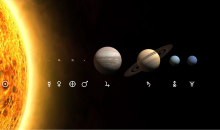Thó-lūn:Tē 9 he̍k-chheⁿ

行星九是一粒佇咧外太陽系的大冰行星的小名,伊是佇 2016 年正月予加州理工學院的天文學家命名的。[2] 行星的存在暗示了一群海王星外天體的行為。[3] 伊可能會是假設的第十五粒行星分散佇尼斯模型內。[4]
研究[kái goân-sí-bé]
The planet, which has not been directly observed, would explain relationships in the orbits of six trans-Neptunian objects in a stable Kuiper belt configuration (Sedna, 2012 VP113, 2007 TG422, 2004 VN112, 2013 RF98, 2012 GB174)[1] that, according to simulation, would only occur with 0.007% probability by chance alone. The researchers found that "capture of KBO orbits into long-lived apsidally anti-aligned configurations occurs (albeit with variable success) across a significant range of companion parameters (i.e., a' ~ 400–1500 AU, e' ~ 0.5–0.8)." The former number represents the semimajor axis and the latter the orbital eccentricity. For their nominal simulation, they selected a' = 700 AU, e' = 0.6, m' = 10 m⊕ (meaning a body with ten times the mass of the Earth), orbital inclination i' = 30°, and initial argument of perihelion ω' = 150°.[4]
Preliminary evidence of Planet Nine was published in 2014, where astronomers from the Carnegie Institution of Science and Hawaii's Gemini Observatory suggested the unusual orbits of certain objects in the Kuiper Belt may be influenced by a massive unknown planet at the edge of the Solar System.[5] Computer simulations by Caltech's Michael E. Brown and Konstantin Batygin, originally developed to refute the 2014 paper, instead provided further evidence that Planet Nine may exist. Brown later described the hypothesized planet as a perturber of extreme Kuiper Belt objects, and speculated that, if current findings prove correct, Planet Nine could have developed into the core of a gas giant had it not been flung into the Solar System's farthest reaches.[2] Brown put the odds for the existence of Planet Nine at about 90%.[2]
軌道佮特性[kái goân-sí-bé]
It is estimated Planet Nine follows an elliptical path around the Sun, with an orbital period of 10,000–20,000 Earth years. The hypothetical planet would have an average orbital distance of roughly 600 astronomical units (AU), or about 20 times the distance of Neptune from Sol, though it may come as close as 200 AU, and would have an inclination of about 30° from the eight known planets.[6][7] The planet is estimated to have 5 to 10 times the mass and 2 to 4 times the diameter of Earth.[2][8] Mike Brown speculates that the planet is most probably an ejected ice giant, similar in composition to Uranus and Neptune: a mixture of rock and ice with a small envelope of gas.[9][2]
Simulations indicate that the mechanism known as mean-motion resonance prevents the TNOs from colliding with Planet Nine, and keeps them aligned.[10] Objects with a semi-major axis less than 150 AU are largely unaffected by the presence of the planet.[4]
Direct detection [kái goân-sí-bé]
Telescopes have begun searching for the object which, due to its extreme distance from the Sun, would reflect little sunlight and potentially evade telescope sightings.[2] It is expected to have an apparent magnitude fainter than 22, making it at least 600 times fainter than Pluto.[9] The primary search is being conducted using the Subaru Telescope and is expected to take about five years.[1]
If the planet is close to its perihelion, astronomers could identify it based on existing image captures. For the most distant part of the orbit, Earth's largest telescopes are required. However, if the planet is currently located in between, many telescopes could spot Planet Nine.[10]
參見[kái goân-sí-bé]
- 冥王星,公認為第九的行星到 2006 年。
- 假設的海王星外行星
- IAU 行星定義
- Tyche
參考[kái goân-sí-bé]
- ↑ 1.0 1.1 1.2 Hand, Eric (20 January 2016). "Astronomers say a Neptune-sized planet lurks beyond Pluto". Science. 20 January 2016 khòaⁿ--ê.
- ↑ 2.0 2.1 2.2 2.3 2.4 2.5 Achenbach, Joel; Feltman, Rachel (2016-01-20). "New evidence suggests a ninth planet lurking at the edge of the solar system". The Washington Post (ēng Eng-gí). ISSN 0190-8286. 2016-01-20 khòaⁿ--ê.
- ↑ Burdick, Alan (20 January 2016). "Discovering Planet Nine". The New Yorker. 20 January 2016 khòaⁿ--ê.
- ↑ 4.0 4.1 4.2 Batygin, Konstantin; Brown, Michael E. (20 January 2016). Ín-iōng chhò-gō͘: 無效的
<ref>標籤;name屬性“TAJ201601”使用不同內容定義了多次 - ↑ Chadwick A. Trujillo and Scott S. Sheppard (27 March 2014). "A Sedna-like body with a perihelion of 80 astronomical units" (PDF). Nature. 507. doi:10.1038/nature13156.
- ↑ "Evidence grows for giant planet on fringes of Solar System". Nature. 2016.
- ↑ Fesenmaier, Kimm (2016-01-20). "Caltech Researchers Find Evidence of a Real Ninth Planet". California Institute of Technology. 2016-01-20 khòaⁿ--ê.
- ↑ Researchers find evidence of ninth planet in solar system
- ↑ 9.0 9.1 Michael E. Brown. "The Search For Planet Nine". 2016-01-20 khòaⁿ--ê.
- ↑ 10.0 10.1 "Caltech Researchers Find Evidence of a Real Ninth Planet". Caltech. 2016-01-20 khòaⁿ--ê.
外部連結[kái goân-sí-bé]
- A new 9th planet for the solar system? (Science Magazine video)
